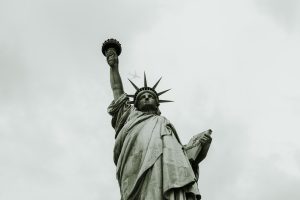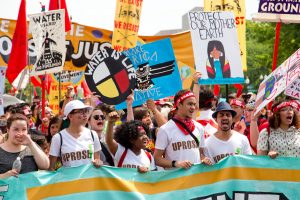Courage, humility, and protest

In the mid 1960s, our church’s youth group, with kids from other Mennonite towns, went to Chicago to help-the-black-people.😇 What we didn’t know.
We worked in a child care center in Markham and other places, learning more than we could ever teach. Then, we got word of the Chicago Freedom Movement’s marches.
With our leaders, we went to New Friendship Baptist and asked it we could march, too. The first answer was no. Why should James Bevel and the rest of the brave Chicagoans allow us goofy, white teenagers to schlepp along on one of their marches for open housing? They were suffering for the cause; we were tourists.
After some negotiation—within their own group, not with us—they sighed and allowed us come. I imagine they sighed. After all, why should they have to spend more than a minute deliberating about small town Ohioans?
We were shown how to roll into a protective ball if beaten—no fighting was allowed—and we went on our first march; later, with much more knowledge and fear, we went on the second, our life views changed forever. We were bothered by ethnic privilege.
I had been taught that quiet people could be brave.

Photo by zelle duda on Unsplash
But, I’d not known that white people could be so unrecognizable.
The Chicago marches were accompanied by violence: the din of shouts and swearing so loud the ears could make no sense of them, but the eyes could read lips; rocks, bricks, firecrackers and bottles thrown with glee by young toughs; bleeding marchers hauled into police vans; cops waving to their white friends in the neighborhoods, while other police put their lives on the line trying to control the crowds; overturned and burned cars; MLK downed by a rock; being chased. (1)
And we Mennonites were nothings, nobodies, mostly kids. One of the adults in our group went back at night after the second march, though, and drove his car out amongst the burning vehicles and marauding youths. We kids went home to our various enclaves, where some of our congregations wondered why we had caused so much violence.
I’ve never seen Roots. I’ll read a pile of books about race in America, but it takes more stoicism than I usually possess to look at movies and most documentaries of those times—although I did make myself look at Eyes on the Prize on YouTube last year for something I was writing. It was hard.
Like all those old folks from the Civil Rights Movement, I’m tempted to look at today’s marches and do a Dana Carvey impression: ‘We marched through Hell, you whippersnappers, and we liked it!’
I didn’t march for a long time after, but in recent years, friends, relatives, and I have pounded the pavement: for collective bargaining, the Women’s Marches, Black Lives Matter, and the March for Our Lives.
Why do people march?
To alert the elected authorities—who are supposed to work for us—that a certain number of people want a shift, and to alert our fellow citizens of the same. Marching is aligned with civic duty, and it may teach our children responsibility to society. (2) I will add, if the marchers are committed to nonviolence.
Last week, David Brookes said on the ‘PBS News Hour’ that he was impressed by the positive nature of the people marching in Washington, D.C. on March 24th:
“But this was a moderate march. And the people were good-hearted. There was a good spirit. There was no culture war fighting. There was no radicalization. It struck me as democracy the way it’s supposed to work.
“And then I followed the feedback on the march on Twitter, frankly, and it’s like I was at a different march. It’s as if [—] they were all radicals, and one set of radicals was shouting at another.
“So it was revelatory to me that the world you see on Twitter is not the real world, and that there are a lot of decent people who have positions, this or that, you can agree with or not [—] it gave me a much more hopeful sense about our democracy, frankly.” (3)
In the first post for this blog, (March 8) I wrote about people hiding in boxes and peeking out to shout at each other.
How do we feel when other groups pop right out of their boxes, not just to shout but to march down the street?

Photo by Vlad Tchompalov on Unsplash
March 26th’s New Yorker has a Portfolio article on kids and guns titled Gun Country:
‘But the children depicted here—hunters, target shooters, and competitors in trap and skeet—occupy a parellel realm, where guns signify not danger, alienation, and the threat of death but safety, discipline, and trust.’ (4)
And, I would add, familial love. (The pictures and the subject disturb me, but that’s me.)
How will they be received by us when they march?
Clearly, I do not address Neo-Nazi and White Supremacist marches here because of the extremities of their actions, which to me are not in line with America’s democratic values.
Something scratches at my brain. Except in violent marches, where folks know what they are getting into and do it anyway because it must be done, as in the Civil Rights struggles, how much courage does it take to march in a group? Well, plenty, when up against another side that is determined to hurt you, as in some of the marches we’ve seen in the past years.
But we all know that there is marching courage, and then there is lonely, individual courage.
The first Chicago march we youth group kids participated in had almost no protection: we marched in groups of two to four and the police barely stopped the angry white youths (and their mothers!) from assaulting us. We were taken by surprise, and we had to think long and hard about signing up for the second march.
But the second march was huge. Our civil rights group filled the streets, the police were more active, and the center provided some protection.
As I walked along, a black girl moving silently into the center from her position at a realty office, where she had been stationed to stand with her little sign in support of open housing.
The look on her face was one I’ve seen in the papers many times since: that look of black courage: fear and shock at the craziness of white people, and determination. I can only imagine what she endured, standing in the midst of the angry white neighborhood with her little sign.
I may never fully understand. But I still haven’t seen Roots.
___________________________________________________________________________
Yesterday marked the 50th anniversary of Martin Luther King’s assassination.
How have the marches you’ve been in affected you? How do you feel about ‘others’ marching?
___________________________________________________________________________
Note: back in 1960s, marchers were assaulted with everything that could be thrown, and with fists and with feet—but not with guns. There just weren’t as many guns available, and it wasn’t in people’s minds to brandish them.
Articles to copy and paste:
(1) A good article about the marches. http://www.chicagomag.com/Chicago-Magazine/August-2016/Martin-Luther-King-Chicago-Freedom-Movement/
(2) NYTimes – marching is good for kids. https://www.nytimes.com/2018/03/12/well/family/why-demonstrating-is-good-for-kids.html
(4) https://www.newyorker.com/magazine/2018/03/26/the-gun-owners-of-the-parkland-generation
_____________
I welcome your comments: gretaholtwriter.com/blog. Please enjoy a few short stories on the Home page, as well.
{Thank you to my niece, Addie Liechty, for taking the picture above that is this blog’s featured image. Her blog is: https://addieswriting.wordpress.com.}